Interviews
Exclusive Interview with Cary Bates
By Barry Freiman[Date: May 2008]
Anyone who read "Superman" comics in the 1970's became very familiar with the name Cary Bates. Bates was one of the principal writers of the adventures of Superman up until the "Man of Steel" reboot in 1986. Bates first began working with DC in 1963 when he sold a now iconic Superman cover to then-editor Mort Weisinger. A few years later, Bates sold his first script to DC and ultimately became one of Superman's principal scribes along with writers Elliott S! Maggin, Martin Pasko, and Len Wein, among others.
After the 1986 revamp, the previous era's Superman writers, including Bates, moved on to other endeavors. Bates scripted a new "Captain Atom" title. Then, after having met and befriended "Superman: The Movie" producer Ilya Salkind while consulting on "Superman III", Salkind turned to Bates to help turn around the live-action "Adventures of Superboy". Bates ultimately became an Executive Story Consultant on the TV show during its second season.
Bates left "Superboy" at the end of the second year to work on Salkind's script to the ill-fated "Christopher Columbus: The Discovery". But Bates' work on the Man of Steel wasn't finished. After the Canon Group botched "Superman IV: The Quest for Peace", Salkind decided to return Superman to the big screen. Salkind, Bates, and Mark Jones (also an Executive Story Consultant on "Superboy") wrote a script for "Superman Reborn". Unfortunately, by this time, Warner Brothers' success with "Batman" led the company to realize there was more money to be made in self-producing their superhero ventures rather than in licensing them to others as they had done with Superman. Warners already had "Lois & Clark: The New Adventures of Superman" in the pipeline and used their contract right of script approval with the Salkinds to bring "Superboy" to an end and to squash "Superman Reborn". Recently, the script to "Superman Reborn" surfaced on the internet and fan reaction to it has been overwhelmingly positive.
The following Superman Homepage interview with Bates reveals his days in comic books may not be completely behind him. Bates discusses his history with DC, Superman, the "Superboy" TV show, and the unmade "Superman Reborn". The Superman Homepage would like to thank Mr. Bates for taking the time for this interview.
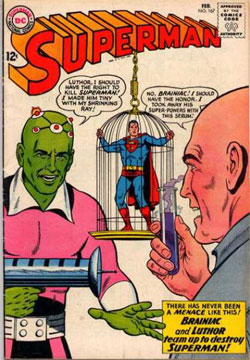 Q: Your first work with DC Comics came from selling DC an idea for a comic book cover - what cover was your first sale, and how did this come about?
Q: Your first work with DC Comics came from selling DC an idea for a comic book cover - what cover was your first sale, and how did this come about?
A: I started submitting cover sketches in '63. The first idea of mine Mort Weisinger used was sent in some time in '63 and ended up the following year on SUPERMAN #167. It was the very first Luthor-Brainiac team-up. I might've been paid a whole $10...but what I clearly remember is receiving the original Curt Swan-George Klein cover in the mail. What they turned in was far superior to my crude sketch but the basic idea and the dialog remained intact. Edmond Hamilton wrote the actual story. Back in those days I still had na�ve aspirations of becoming an artist. Writing scripts hadn't occurred to me yet.
Q: What was the first story you penned for DC?
A: It was an imaginary story I wrote over Thanksgiving break from Ohio University in 1966. It ran the following spring in an issue of World's Finest... something about Batman being Luthor and Bruce Wayne being Superman (or was it the other way around?) Like all my early stories, I would submit a cover idea first. Once that was accepted, Mort and I would work out the plot for the accompanying script.
Q: What were the biggest differences between working for Mort Weisinger and Julie Schwartz?
A: They were both geniuses in their own right, and although they were always cordial to each other, by the time I met them it was impossible to imagine them as teenagers who were once putting out fanzines together. Each man had very definite ideas about what made a good comic and both would take an active role in co-plotting every story with their writers. Of the two Mort was a bit more rigid and dogmatic. Julie had very specific likes and dislikes as well... though as time went on he was more flexible and open to new ideas. After 1971 he was working primarily with writers under 30 who had replaced the so-called "old guard" (John Broome, Gardner Fox, Bob Kanigher, etc). Mort on the other hand retired in 1970, just before the major influx of younger writers began. Although he was obviously more comfortable with seasoned pros, to his credit Mort bucked the status quo when he brought both myself and Jim Shooter into the business. And Shooter was even younger than I was.
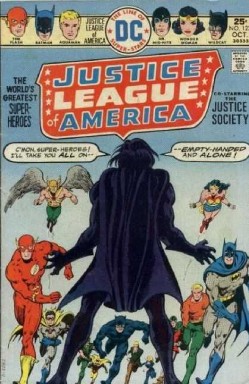 Q: During your run on Superman, the character and stories seemed to start growing up, and comics generally began to appeal to older readers - was this a conscious choice?
Q: During your run on Superman, the character and stories seemed to start growing up, and comics generally began to appeal to older readers - was this a conscious choice?
A: From 1967 on, I was writing one or two Superman (or Superman-related) scripts a month and this pace continued more or less for 19 years...so over the course of two decades and several hundred stories, the stuff I was doing was bound to evolve, just as comics in general had begun aiming for older readers. Shifting editorial policies played a role here as well, since Mort's books were split between Julie and Murray Boltinoff, the one exception being Jimmy Olsen which went to Jack Kirby. Both Julie and Murray were striving to take Superman beyond the now-familiar confines of the Weisinger-era.
Q: Several characters you introduced during your run cliqued with readers and became fixtures in the myth during the 70s and 80s. One such character was Terra-Man, a space cowboy who rode a winged horse. How did you develop the Terra-Man character?
A: It was the result of just another plotting session with Julie. Either he or I had hit on the idea of a space-cowboy character as a new villain. I remember him being particularly keen on the Old West origin, the idea of combining the s-f genre with a western. It was my idea to give Curt Swan some of Clint Eastwood's Man With No Name imagery as reference.
Q: Anyone who read Superman in the 1970s became very familiar with the pairing of Cary Bates, writer, and the late Curt Swan, penciller - how did this pairing develop? Did you have a close working relationship with Swan?
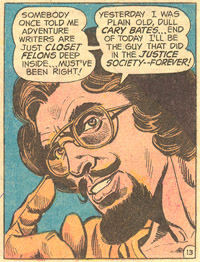 A: We probably didn't meet for the first few years, since most of the scripts I wrote from '67 to 71' were mailed in from Ohio. Once I was living in New York full time we'd see each other now and then up at DC. Curt was always complimentary about my scripts and I was thrilled to see so many of my scripts being drawn by him, especially the ones inked by Murphy Anderson.
A: We probably didn't meet for the first few years, since most of the scripts I wrote from '67 to 71' were mailed in from Ohio. Once I was living in New York full time we'd see each other now and then up at DC. Curt was always complimentary about my scripts and I was thrilled to see so many of my scripts being drawn by him, especially the ones inked by Murphy Anderson.
Q: Often you co-wrote with the other famed 1970s Superman scribe, Elliott S! Maggin and you even appeared together in a "Justice League of America" story. Did you and Maggin enjoy working together? How was the process of co-authoring a story different from being a solo writer on a story?
A: We had fun on those team ups but I think it only happened four or five times on Superman and of course there was the infamous two-part JLA-JSA crossover where both myself and Elliot (as well as Julie Schwartz) came over from Earth Prime and guest-starred in the story. When we co-wrote usually I would do the panel breakdowns and Elliot would write the dialog.
Q: When you wrote Superman, who was the real character and the disguise in your mind as between Clark Kent and Superman?
A: Throughout the Weisinger-Schwartz eras when I was writing Superman, I always looked on the character as a sort of hybrid. From the day of his arrival he was a super-powered Kryptonian and a Kent... though I suppose most of my stories leaned a bit more toward the alien-pretending-to-be-human persona. I know that flies in the face of the more recent incarnations (Byrne, post-Byrne, the Smallville TV show, etc) that place more emphasis on the Clark Kent personality being the 'real' one.
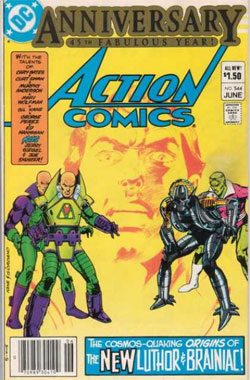 Q: For Superman's 45th anniversary, DC revamped the Luthor and Brainiac characters. You wrote the Luthor story in Action #544 which gave Lex his "Super Powers" warsuit. Did you develop the specifics of the revamp or was it handed down editorially?
Q: For Superman's 45th anniversary, DC revamped the Luthor and Brainiac characters. You wrote the Luthor story in Action #544 which gave Lex his "Super Powers" warsuit. Did you develop the specifics of the revamp or was it handed down editorially?
A: That was all me, just plotting the story with Julie as usual. As I recall, that was the story where the planet Lexor blew up and Lex ended up blaming Superman for it.
Q: When DC decided to reboot Superman in 1986, you were given an opportunity to pitch your own idea. What do you recall about your pitch?
A: Ironically it combined two of the themes DC would later incorporate in separate storylines years apart: de-powering (the Byrne reboot) and death (the Doomsday arc). My scenario called for a five or six part mini-series in which Superman 'died' first and was reborn later, inside a yellow sun. I believe I proposed introducing some never-before-revealed wrinkles in Kryptonian physiology that made this possible, but at a steep cost. The regeneration process permanently consumed a lot of Superman's inherent energy, in effect "de-powering" him. I recall using the analogy of what happened to the Michael Rennie Klaatu character in the classic SF film The Day the Earth Stood Still. When Gort brought him back to life, Klaatu explained he wasn't the same being he used to be and his life-extension could end at any moment. I didn't propose going this far with Superman, but I did think the concept of a Superman who finds he can't do all the stuff he used to take for granted (moving planets, unassailable invulnerability, etc) could have been an interesting avenue to pursue. Of course, my reboot wouldn't have addressed the issue of all the Silver Age Weisinger baggage that Byrne chose to dispense with.
Q: Did you feel a complete reboot of the character was necessary? After the reboot, it seemed there was a conscious effort by DC to remove the writers and artists associated with the pre-Crisis Superman from the post-Crisis Superman titles. Did you feel this was the case?
A: Absolutely. And though it made for some difficult times for quite a few of us, from a marketing perspective the clean sweep in creative teams made business sense.
Q: As someone who worked on the Superman character when Superboy was still a big part of the character's past, how did you feel about the removal of Superboy from continuity in the John Byrne revamp (though even Byrne has since admitted he goofed in removing the Boy of Steel from the back story)?
A: I could see the reasoning behind this, especially in the aftermath of the first Superman movie, which certainly demonstrated how effective the dramatic impact of introducing Superman to the world as an adult could be. But Byrne's change of heart points up how ideas that can seem intriguing in the short term sometimes do not always hold up well in the long run. I'm sure some people might place the controversial Clark-Lois marriage in this category as well.
Q: In the early 1980s, you met and developed a friendship and business relationship with "Superman" movie Producer Ilya Salkind. How did that come about?
A: Halfway through production of Superman III, DC sent me to Pinewood studios in 1983 as their official representative in meetings with Ilya, Pierre Spengler, Richard Lester and Leslie and David Newman. There were concerns over the tone of the film leaning too much toward Richard Pryor at Superman's expense, but we were stymied by Lester and our efforts proved to be too little too late. But it was the beginning of my long-running association and friendship with Ilya, which continues to this day (we have a project currently in development I'm not at liberty to discuss).
 Q: How did you start working with Salkind on the syndicated "Adventures of Superboy" TV show? Ultimately you and Mark Jones became Executive Story Consultants on the show - what were your responsibilities in that capacity?
Q: How did you start working with Salkind on the syndicated "Adventures of Superboy" TV show? Ultimately you and Mark Jones became Executive Story Consultants on the show - what were your responsibilities in that capacity?
A: The Superman III experience obviously had a lot to do with my involvement. Though it was originally intended to only be a 13 episode sabbatical from comics, I ended up in Florida for five years, staying on for another season of Superboy, followed by screenwriting stints on the Salkinds' Christopher Columbus movie and the unfilmed Superman Reborn, which would have marked the Salkinds' return to the Superman film franchise.
Q: Was it your idea to bring on comic book writers like Mike Carlin, Denny O'Neil, and J.M. DeMatteis to pen show scripts?
A: Mike and Andy Helfer were already attached as writers for the show via DC. I brought Denny in, but DeMatteis didn't come on board until the 3rd season, after I left.
Q: What prompted the changes to the show in its third season that had Clark and Lana interning with the Bureau of Extra-Normal Matters?
A: By then I was off working on the Columbus film... but I believe it was a joint decision between Viacom and DC.
Q: How did the idea for "Superman V" or "Superman Reborn", which you wrote with Ilya Salkind and Mark Jones, come about? (Were you aware the script has recently been published online and generally been very well-received by fans who've even said it'd make a great sequel to "Superman Returns"?)
A: A Superman film treatment I had previously done on spec in the 80's (and gotten nowhere with Warners) was the catalyst. During Superboy's second season I showed it to Ilya, and he decided there was enough good material there to serve as a "jumping off point" for a new Superman movie. This prompted him and his father to reactivate the franchise (which they had leased to the Cannon group for the ill-fated Superman IV); subsequently I signed a deal to develop a full screenplay with Mark Jones as co-writer.
Q: How far did the "Superman V" project get as you recall? I understand Chris Reeve considered returning to the role. Why do you think the project never happened?
A: We were in the initial stages of pre-production. The film had been budgeted and they had hired a production designer who came up with some great stuff (I can still recall his kick-ass designs for Brainiac's ship). Unfortunately, other forces were at work we weren't aware of at the time. Final script approval never came down from Warners because they had their own plans for the character - the newly commissioned Lois and Clark series. It wasn't long after that when the Salkinds began negotiations to sell all their Superman rights back to the studio. Given the success of the Superman films and the more recent Batman franchise, by the early '90's WB had realized in hindsight they were remiss in letting go of the rights to their flagship comic book character.
Q: How did you get involved in co-penning "Christopher Columbus: The Discovery"?
A: Right place, right time. I had just finished the first draft of Superman Reborn when the Salkinds needed another writer on Columbus. They had contracted Mario Puzo for the first draft, John Briley (Ghandi) for the second... but both writers were unavailable to continue with the project. By this time Ilya was comfortable working with me so I got the gig. Unfortunately, both this Columbus movie and the competing Columbus film by Ridley Scott underperformed at the box office, but for me it was still a great experience. Being an avid James Bond fan (I sold a film treatment for Moonraker to Cubby Broccoli in the 70's) getting to work with John Glen was a blast, and I went all over Europe for three months on location with the film crew.
Q: Ilya Salkind's gotten kind of a bad rap by fans over the years, particularly over the issues with Richard Donner, but you worked with him on "Superman III", "The Adventures of Superboy", "Christopher Columbus: The Discovery", and the unmade "Superman V" script. Do you have any insights on the man?
A: What the naysayers seem to overlook is that without Ilya's vision and ambition, Superman I - which provided the template for most of the super-hero movies that have come since - might not have happened at all. Ilya was the first to see the potential Superman had as a big budget film with A-level talent at a time when the rest of the business considered comic book properties Saturday morning material at best. Even the '60's Batman TV show only attained its brief surge in the ratings by trashing and ridiculing the source material. With respect to Superman III, most fans are not aware that the most interesting (and praised) elements of the film - the schizophrenic split and fight between the evil Superman and the heroic Clark - were Ilya's concepts. The hokey super-computer and emphasis on Richard Pryor scenes were coming from the Lester camp, no pun intended. If Superman Reborn - which contained many more of Ilya's concepts - had reached the screen, it would have gone a long way toward erasing the so-called 'bad rap' you speak of.
Q: How do you feel about the start of an internet campaign to get Warners to release seasons 2-4 of "Superboy" on DVD?
A: More power to them. Unfortunately, with the DVD marketplace being as crowded as it is, many series collections never get past disc one if the initial set doesn't meet sales expectations. People interested in adding their names to the Superboy campaign should check out Superboyhomepage.com.
Q: Do you have any feelings one way or another on the legal problems that have been going on between Warners and the heirs of Jerry Siegel, particularly given the fight is largely about Superboy the character?
A: I'm staying away from that one, other than to say I'm surprised it's dragged on this long. At this stage of the game it's all about money and future income potential, so all the parties involved will no doubt reach a monetary settlement. Hopefully sooner than later.
Q: Do you keep up with "Superman" comic books today?
A: Occasionally I check out the one-shots or special issues that are set apart from regular continuity. I've been particularly impressed with Mark Millar's Red Son, Kurt Busiek's Secret Identity mini-series and the Grant Morrison All-Star Superman.
Q: Any interest in writing "Superman" again someday?
A: Now that I'm finishing up a new mini-series for Marvel (True Believers, due out this July), that notion isn't as far fetched as it might have seemed a year or two ago. In fact, I'm currently in talks with DC about a project for 2009, but at this stage it's way too soon to go into any detail.
This interview is Copyright © 2008 by Steven Younis. It is not to be reproduced in part or as a whole without the express permission of the author.
Interviews
Introduction
The Superman Homepage has had the pleasure of interviewing various Superman Comic Book creative people about their work.
Question and Answer Interviews:
- Interview with writer Marv Wolfman about Man and Superman: The Deluxe Edition (November 2019)
- Interview with artist Claudio Castellini about Man and Superman: The Deluxe Edition (November 2019)
- Interview with artist Joe Staton about working on Superman properties over the years (November 2019)
- Interview with Christopher Priest about the Superman vs. Deathstroke story in Deathstroke #8 (November 2016)
- Interview with Sterling Gates about the 'Adventures of Supergirl' digital-first comic book series (January 2016)
- Interview with J. Michael Straczynski about “Superman: Earth One - Vol. 3” - Writer J. Michael Straczynski talks to us about the third volume in the “Superman: Earth One” graphic novel series (February 2015)
- Interview with Jim Krueger - Writer Jim Krueger talks to us about his “The Dark Lantern” story in the “Adventures of Superman” comic book title (November 2013)
- “Smallville: Season 11” Interview with Bryan Q. Miller - Writer Bryan Q. Miller talks to us about his work on the “Smallville: Season 11” comic book title (October 2012)
- “Supergirl” Interview with Mahmud Asrar - Artist Mahmud Asrar talks to us about his work on the monthly “Supergirl” comic book title (July 2012)
- “Superman/Batman” Interview with Joshua Hale Fialkov - Joshua Hale Fialkov answers our questions about “The Secret” 3-part story in “Superman/Batman” #85-87 (July 2011)
- “Supergirl” Interview with Sterling Gates - Sterling Gates answers our questions about where Supergirl is headed post “War of the Supermen” (June 2010)
- “Supergirl” Interview with Sterling Gates & Jamal Igle - Adam Dechanel chats with the “Supergirl” comic book team about the Maid of Might (March 2010)
- Behind the Scenes of the Super Friends - Four part indepth look at the “Super Friends” comic book title with artists J. Bone and Stewart McKenny (February 2010)
- Interview with Landry Q Walker and Eric Jones - The writer and artist discuss Supergirl: Cosmic Adventures in the Eighth Grade (May 2009)
- Interview with Elliot S! Maggin - Legendary Superman writer and novelist discusses his career (January 2009)
- Interview with J. Bone - Artist discusses Super Friends comic book (November 2008)
- Interview with Mark Bagley (September 2008)
- Interview with J. Torres - Writer discusses Legion of Super Heroes in the 31st Century #18 (September 2008)
- Interview with Jake Black (May 2008)
- Interview with Cary Bates (June 2008)
- Interview with Jack Briglio - Writer discusses Legion of Super Heroes in the 31st Century #14 (May 2008)
- Interview with Ken Pontac - Writer discusses Justice League Unlimited #44 (May 2008)
- Interview with Karl Kerschl (April 2008)
- Interview with J. Torres - Writer discusses Legion of Super Heroes in the 31st Century #13 (April 2008)
- Interview with J. Torres - Writer discusses Legion of Super Heroes in the 31st Century #11 (February 2008)
- Interview with Fabian Nicieza - Writer on Superman comic books (June 2007)
- Interview with Danny Fingeroth - Writer of the book Superman on the Couch (May 2007)
- Interview with Jesse McCann - Writer on the Krypto The Superdog comic books (December 2006)
- Interview with Matt Haley - Artist on the Superman Returns comic book movie adaptation (November 2006)
- Interview with Ethan Van Sciver - Artist on Superman/Batman (September 2006)
- Interview with Mark Verheiden on taking over the writing duties on Superman/Batman (April 2006)
- Interview with Matt Idelson on taking over as Superman group editor (March 2006)
- Interview with Jeph Loeb on Sam and “Superman/Batman #26” (February 2006)
- Interview with Roger Stern (December 2005)
- Interview with Marv Wolfman (November 2005)
- Interview with Gail Simone (May 2005)
- Interview with Greg Rucka (April 2005)
- Interview with Brad Meltzer [Identity Crisis] (January 2005)
- Interview with Glenn Whitmore (November 2004)
- Interview with Jeph Loeb (September 2004)
- Interview with Karl Kerschl (September 2004)
- Interview with Ron Garney (September 2004)
- Interview with Greg Rucka and Matthew Clark (May 2004)
- Interview with Ed McGuinness (March 2004)
- Interview with Brad Meltzer [Identity Crisis] (March 2004)
- Interview with Mark Millar [Superman: Red Son] (March 2003)
- Interview with Min S. Ku (September 2001)
- Interview with Jeph Loeb (May 2001)
- Interview with Joe Casey (April 2001)
- Interview with Mike S. Miller (September 2000)
- Interview with Denis Rodier (August 2000)
- Interview with Grant Morrison (December 1999)
- Interview with Mark Millar [Part 2] (November 1999)
- Interview with Mark Millar [Part 1] (April 1999)
Interviews/Articles:
- “Superman vs. Terminator” - A Chat with Fight Promoter Alan Grant. (January 2000)
- Superman: The Dailies (1939-1940) Graphic Novel Review.
- The Rebirth of Superman (Part 1) - Superman is reborn... again.
- The Rebirth of Superman (Part 2) - Eddie Barganza on taking the character in a new direction.
- The Rebirth of Superman (Part 3) - Jeph Loeb discusses writing the Man of Steel.
- Lex Luthor For President - Forget Superman. An updated Luthor's new enemies are Gore and Bush.
- Superman: Last Son of Earth - Steve Gerbern Interview - The writer discusses flip-flopping the Man of Steel's origin. (August 2000)
Krypton Club Interviews:
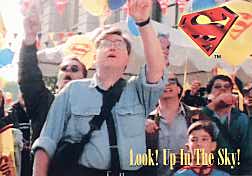 When “Lois & Clark” started production in 1993, there was an obvious relationship between the comic book people and the Hollywood people.
When “Lois & Clark” started production in 1993, there was an obvious relationship between the comic book people and the Hollywood people.
A trade paperback “Lois and Clark: The New Adventures of Superman”, was published, with Dean Cain and Teri Hatcher on the cover. It included reprints of comic book stories that were the inspiration for “Lois & Clark”, helping to define the characters. Comic's included are: The Story of the Century (Man of Steel miniseries #2), Tears for Titano (Superman Annual #1), Metropolis - 900 mi (in SUP #9), The Name Game (SUP #11), Lois Lane (in ACT #600), Headhunter (AOS #445), Homeless for the Holidays (AOS #462), The Limits of Power (AOS #466), and Survival (ACT #665).
A number of comic book writers and artists had roles as extras in the episode “I'm Looking Through You” (Season one, episode 4). Their presence was immortilized in the Sky Trading Card #34.
Craig Byrne, president of the online “Lois & Clark” fanclub The Krypton Club, carried out a series of interviews with comic book writers. The interviews are reprinted with permission of the Krypton Club.
- Interview with Roger Stern (June 1995)
- Interview with John Byrne (June 1995)
- Interview with Mike Carlin (July 1995)
